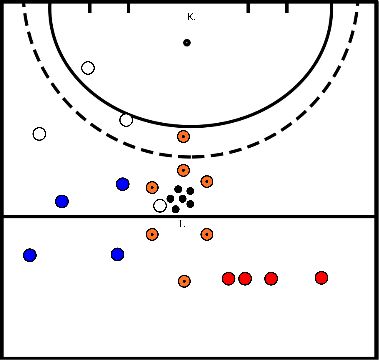Hockey drills
- Make sure that your left foot reaches the same height as the ball during your run-up
- You should place your foot about 30 cm away from the ball, so that you have enough space to place your stick near the ball
- At a high level, the drag flick is a common variant of the penalty corner.
- It is also the only variant where the ball can be played at high speed, high on the goal.
- Below, the basic technique of the sledge push is explained in 4 steps.
- The backhand stroke is useful for a shot on goal but also to pass to your teammate.
- With the backhand, you place your left hand at the end of your stick and your right hand slightly above the middle of your grip.
- Usually you play a backhand from the barrel.
- When your right foot is in front you let the ball roll a little bit.
- Meanwhile you turn your stick to the backhand, you bend your right knee and then you hit the ball with the part of your stick just above the curl (make sure the ball doesn't stick in the curl otherwise you have no control over it).
- You can make the ball go low or high by turning your stick.
- With a diagonal stick the ball flies upwards, with a straight stick it stays on the ground.
- Sit-ups Make 2 pairs so that the players can take turns holding each other's feet.
- Each player does these sit-ups: 10 times, 15 times, 20 times during which they rest by helping the other.
- Put two players opposite each other in push-up position:
- Have them try 1 by 1, 5 times in a row, to wipe each other's hands underneath.
- Let them do this 3 times.
- Everyone stands on their toes behind the back line, with their toes against the line.
- Start by jumping 10 times on the line with your toes and jump back behind the line.
- Build this up to 15 times and finally 20 times.
- Always keep a 20 second rest during this exercise.
High tempo switching in a match form.
- 3 teams (blue, red & white);
- Each team consists of 3, 4 or 5 players;
- Attacking team (A) has 1 player in excess (so 3:2, 4:3 ...);
- One player of the defending team (B) stands in the box next to the trainer;
- Non-playing team (C) stands at the centre line;
- When A has scored, they defend with n-1 men;
- Team B sets up at the half way line and then attacks.
- Left-right alternate.
- Coach puts ball in play.
- Turn over:
- Attack on the left: Blue attacks, white defends, red is ready on the right (II)
- Attack on right: Blue defends (n-1), Red attacks, White prepares on left (I)
- Attack over left: White attacks, Red defends (n-1), Blue stands ready (II)

- Pairs face each other.
- Ball between them.
- Players stand with their hands behind their backs.
- As soon as BAL is called they try to grab the ball as fast as possible.
- Who catches it first, wins.
The game is played with at least 4 players
- 1 mouse who has a t-shirt or piece of cloth in the back of his trousers
- 1 dog who has a tennis ball
- 2 cats without attribute
- the mouse runs around with the dog,
- the cats try to grab the tail of the mouse and bring it to their cone
- But the dog can tap the cat with the tennis ball and it will do a punishment of its choice in the camp.
- If there are more players a group can be created and 2 games can be played together.
- The whole group stands behind a line at the side of the field.
- On signal they walk over to the other side.
- Variation: Initial positions:
- squat
- knee,
- prone or supine,
- Sit with back to walking direction.
- From the group, a scapegoat is appointed.
- The game is played all over the field.
- The group is lined up on one side of the field.
- On sign the children cross the field.
- One of the catchers tries to catch as many children crossing the road as possible.
- Variation
- The children walk to and fro on a signal.
- Back and forth without waiting for a signal.
- The children are not free on the other side.
- With two tappers.
- With boxes where there is one ticker in each box.
- The children can be tagged in every cell.
- Who has not been tagged on the way out and on the way back?
- Or which group of tickers has managed to tick the most children?
- The group stands on one side behind these hoops.
- When told to do so, the children steal objects from the other side and place them in the hoops on their own side.
- If they are caught by a ticker, they have to put the object back.







